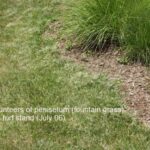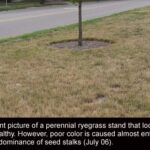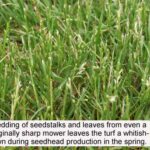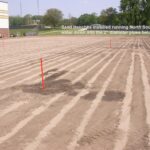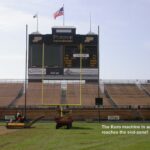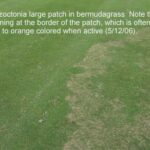Turf Tips Archives
Summer stress of Poa annua and Poa trivialis in Lawns and Sports Fields
Persistent air temperatures of 90F and soil temperatures greater than 80F combine with high humidity and adequate rainfall (in some areas) is also doing in the Poa annua (annual bluegrass) and Poa trivialis (rough bluegrass)on lawns and athletic fields. Patches of these fine-bladed grasses seemingly die overnight with even a minimum of drought stress. Though […]
Bumper Crop of Crabgrass and Yellow Nutsedge
The rain and 90F temperatures have boosted the growth of both crabgrass and yellow nutsedge in the last week or two. Unfortunately, our options for control of either weed are becoming limited. Plus the hot temperatures increase the risk for turf damage with any herbicide applied now. The best current option for crabgrass is Drive […]
Brown Patches in Lawns Could be Escaped Fountain Grass
Fountain grass and other ornamental grasses have added tremendously to the urban landscape. However, we are now seeing some of these grasses escape from the ornamental beds into the turf. One in particular is fountain grass (Penisetum spp) because it produces viable seeds which blow into surrounding turf and may germinate. Though most of the […]
Brown Patches in Lawns Could be Old Seedstalks
We have received a number of calls, email, and electronic photos inquiring about current brown patches in the lawn. Dollar spot is active throughout the state and could be causing problems in lawns. Dollar spot causes very noticeable lesions and cotton candy mycelium in the early morning. However, many of the patches that I have […]
Bermudagrass Takes Root in Ross-Ade and the South Football Practice Field
It is in some ways difficult to believe that it has been just over one month since the first “Big Rolls” of ‘Patriot’ bermudagrass were installed in Ross-Ade stadium on 6 June, 2006. The sod 42” wide rolls arrived on refrigerated trucks from the sandy coastal plain soils of Eastern Maryland. Some of you may […]
Midwest Regional Turf Field Day on July 18
Don’t forget to register for the Midwest Regional Turf Field Day that will be held on July 18 at the W.H. Daniel Turfgrass Research and Diagnostic Center in West Lafayette. This is a great opportunity for turf professionals to view the latest in turfgrass research, talk to Purdue specialists about turf and ornamental issues, and […]
Japanese Beetles: They’re Back!
The first Japanese beetles of the year were observed in central Indiana last week and now is a great time to review the biology and control of these pests. Japanese beetle adults pupate from larvae in late spring and begin emerging at this time of the year. We expect them to arrive in full force […]
Bermuda suppression in zoysia?
Bermudagrass is one of the most difficult species to control due to its extensive stolon and rhizome system, aggressive growth, and tolerance to management and environmental extremes. It is even more difficult to control selectively in another warm season grass, thus it can be a problem wherever zoysiagrass is grown as the desirable turf. Recent […]
More on Nematodes and Indiana Greens
As our nematode survey continues, more questions are being asked about nematodes, their damage potential, etc. Following is an update on the survey: Do not attribute all vague symptoms to nematodes. Nematode populations and symptoms are extremely complex and cannot be diagnosed by anyone other than a nematologist. In other words, don’t panic. […]
Seedheads Make for Tough Mowing
Kentucky bluegrass, tall fescue, and perennial ryegrass are now producing seedheads. This natural phenomenon is induced by daylength and occurs every spring. Seedheads detract from the appearance of a turf because they grow quickly and unevenly and the tough seed stalks do not cut cleanly except with the sharpest of mower blades. After mowing, the […]
Red thread, pink patch, and dollar spot in lawns and roughs
Red thread and its close relative pink patch, are now appearing on home lawns (and golf course roughs) in the central and southern parts of Indiana. Red thread first appears as small (quarter to golf ball size) gray – tan colored patches in the turf. After extended dew periods, white – pink mold may be […]
Football Renovations Continue (Part 2)
Tremendous progress has occurred since our last update, 17 May, on the projects to enhance the football practice and game fields at Purdue University. These have been exciting times for all those associated with the Turf program as we have been able to witness three different turf renovation projects all occurring simultaneously. It has truly […]
Finding Spring Grubs?
Each spring we receive many calls about grubs as people find them while planting gardens or ornamental beds. These are often large and appear menacing however do not let their appearance cause you to worry, panic or run out to buy an insecticide to annihilate these sinister creatures. These grubs are not feeding actively so […]
Ross-Ade and South Football Practice Field Renovations – Update 17 May 2006
After nearly a week of steady rain in West Lafayette and across the region, work was finally able to continue on the Ross-Ade stadium and South football practice field renovations. The existing Kentucky bluegrass/perennial ryegrass turf in Ross-Ade was removed today with a “Koro” machine. The machine is essentially analogous to a milling machine used […]
Aerification Following Preemergence Herbicide?
In theory, a barrier of preemergene herbicide is created in the soil and limites emergence of crabgrass. Any gap in this barrier could allow crabgrass to germinate. This is why a uniform application of preemergence herbicide is required and practices like power raking or aerification are usually not recommended after application. However, research consistently shows […]
Pink Snow Mold Active
The cool wet weather the last two weeks is favoring Microdochium nivale, the pathogen that causes pink snow mold (sometimes referred to as Microdochium patch). The color of pink snow mold scars indicates the activity of the patch. Straw colored patches are usually inactive. However, a rust to orange colored band or ring indicates an active […]
Rhizoctonia Large Patch in Bermudagrass
With the continued cool wet weather, Rhizoctonia Large Patch (RLP) is affecting bermudagrass fairways. Prior to widespread use of bermudagrass in southern Indiana and northern Kentucky, we thought RLP affected only zoysia and was thus known as zoysia patch. However, RLP caused serious thinning in bermudagrass in an occasional spring the last few years. This […]
Rhizoctonia Large Patch (Zoysia Patch) in Zoysia
With the continued cool wet weather, Rhizoctonia Large Patch (RLP or zoysia patch) is in high gear. This follows a warm winter that also encouraged RLP, which is the only major disease of zoysiagrass in Indiana. Like snow mold, a rust to orange colored band on the outside of the patch indicates activity. Though best […]
Nematode Damage in Golf Greens
We are suspecting more and more instances of actual nematode damage or at least secondary effects of nematodes in golf greens. Effects of nematode feeding would include yellowing, thinning, enhanced drought stress, and other symptoms reflective of a poor root system. Unfortunately, symptom expression may be enhanced or complicated by poor rooting from summer weather, […]
